Dans des industries comme exploitation minière, pétrole et gaz, formage des métaux, travail du bois, et la fabrication, les matériaux résistants à l'usure sont essentiels.
Lorsque les équipements fonctionnent dans des environnements difficiles, les pièces doivent résister aux frottements, à la pression, à la chaleur et à la corrosion. Deux des matériaux les plus courants pour pièces d'usure sont en carbure de tungstène et en acier.
Choisir le bon matériau peut avoir un impact sur la productivité, les coûts et les temps d'arrêt. Cet article compare le carbure de tungstène et l'acier en termes de performances, de coût, de durabilité et d'applications optimales, aidant ainsi les décideurs à choisir le matériau le plus adapté à leurs activités.
Qu'est-ce que le carbure de tungstène ?
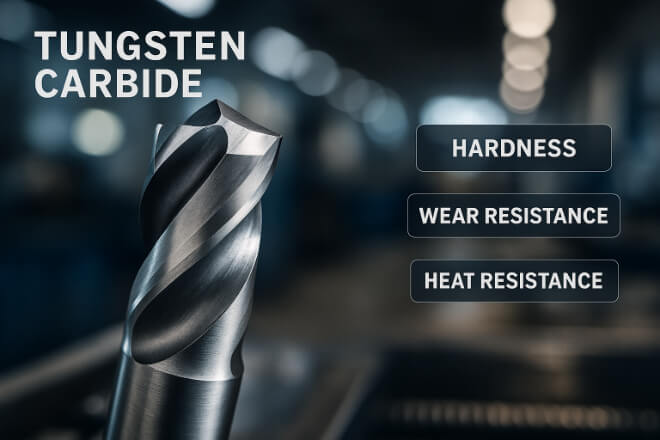
Le carbure de tungstène est un composé composé d'atomes de tungstène et de carbone. Il est extrêmement dur – presque aussi dur que le diamant – tout en offrant une bonne ténacité.
Cela en fait un choix idéal pour les pièces d'usure soumises à une abrasion constante ou à des conditions extrêmes.
Principales propriétés du carbure de tungstène :
Très élevé dureté (8,5–9 sur l'échelle de Mohs)
Excellent résistance à l'usure
Haute résistance à la chaleur
Bonne résistance à la corrosion
Longue durée de vie
Les utilisations courantes comprennent les outils de coupe, les forets miniers, les joints de pompe, les chemises d'usure et les matrices de précision.
Qu'est-ce que l'acier ?
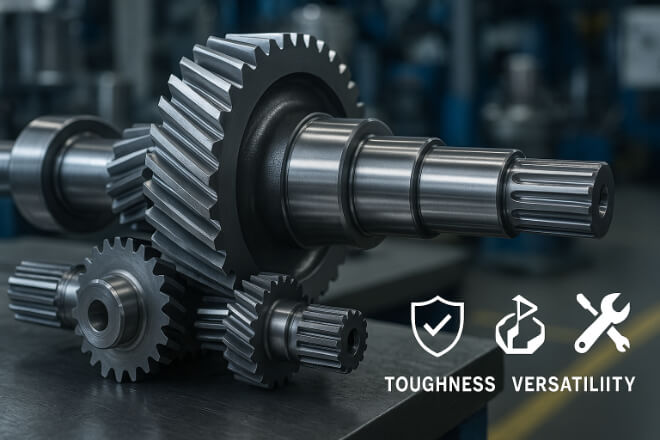
L'acier est un alliage composé principalement de fer et de carbone, souvent avec d'autres éléments comme le chrome, le nickel ou le manganèse pour améliorer les performances.
L'acier est populaire car il est solide, résistant et polyvalent. Il est également plus facile et moins cher à usiner et à souder que le carbure de tungstène.
Principales propriétés de l'acier :
Haut dureté et la force
Plus facile à usiner et à façonner
Rentable pour les grandes pièces
Différentes nuances pour différentes utilisations (par exemple, acier à outils, acier inoxydable, acier à haute teneur en carbone)
L'acier est largement utilisé pour les engrenages, les arbres, les pièces structurelles et les composants d'ingénierie générale.
Carbure de tungstène et acier : comparaison des propriétés
| Propriété | Carbure de tungstène | Acier |
|---|---|---|
| Dureté | Extrêmement élevé (8,5–9 Mohs) | Inférieur (4–8 Mohs, selon le grade) |
| Résistance à l'usure | Excellent, idéal pour les conditions abrasives | Bon, mais s'use plus vite sous l'abrasion |
| Résistance à la chaleur | Très élevé, conserve sa dureté à haute température | Modéré, peut perdre sa dureté à des températures élevées |
| Résistance à la corrosion | Élevé, surtout avec les revêtements | Variable — l'acier inoxydable résiste bien à la corrosion |
| Dureté | Modéré (peut s'écailler en cas de choc violent) | Élevé, meilleur pour les charges d'impact |
| Usinabilité | Difficile, nécessite des outils diamantés ou en carbure | Facile à usiner avec des outils standards |
| Coût | Plus haut | Inférieur |
Durabilité dans des conditions difficiles
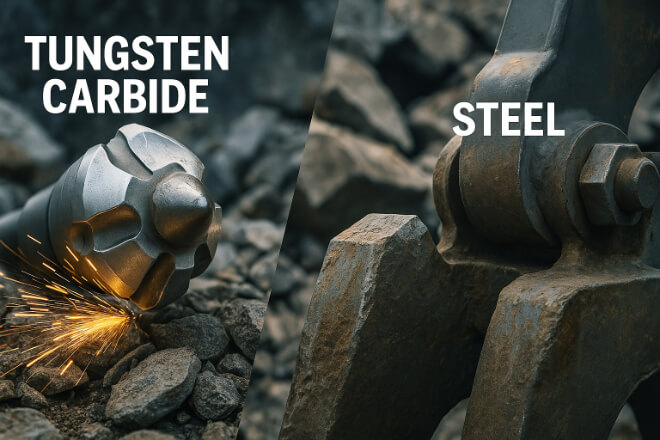
Le carbure de tungstène brille en matière de résistance à l'usure et à l'abrasion.
Dans l'exploitation minière ou le formage des métaux, les outils et composants en carbure de tungstène durent souvent 3 à 10 fois plus longtemps que leurs équivalents en acier. Cela réduit les temps d'arrêt et les coûts de remplacement.
Cependant, l’acier peut surpasser le carbure de tungstène lorsque les pièces sont exposées à des impacts importants ou à des forces de flexion.
L'acier est en hausse dureté signifie qu'il peut absorber les chocs sans se fissurer, ce qui le rend meilleur pour certaines applications structurelles.
Considérations relatives aux coûts
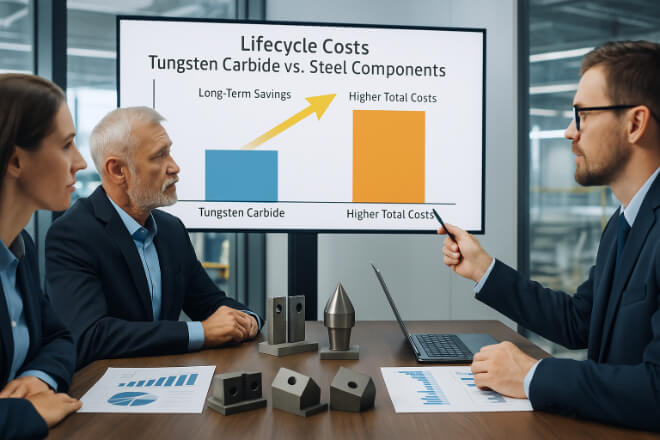
À première vue, les pièces en carbure de tungstène coûtent plus cher que l'acier. Cependant, si l'on prend en compte le coût total du cycle de vie (remplacements, temps d'arrêt et maintenance compris), le carbure de tungstène s'avère souvent plus économique.
Par exemple, une matrice de découpe en carbure de tungstène peut coûter 2 à 3 fois plus cher qu'une matrice en acier, mais durer 5 à 10 fois plus longtemps, ce qui en fait le meilleur investissement dans de nombreux cas.
Adéquation de l'application
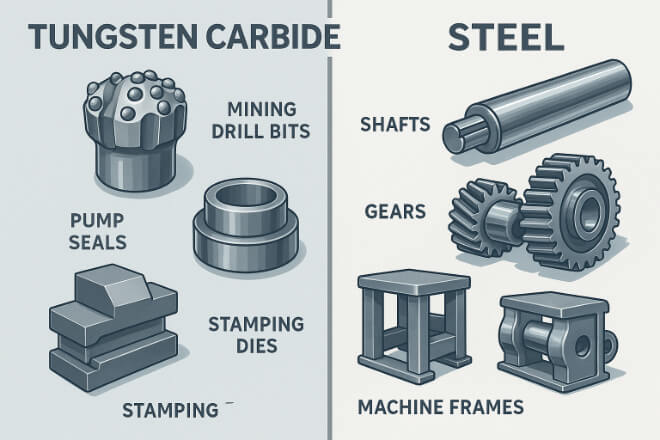
1). Quand utiliser le carbure de tungstène :
Usure et abrasion extrêmes
Températures élevées
Tolérances de précision
Fonctionnement continu avec un temps d'arrêt minimal autorisé
1.1). Exemples :
Trépans de forage minier
Joints de pompe dans pétrole et gaz
Matrices d'emboutissage de métal
Lames de travail du bois
2). Quand utiliser l'acier :
Chocs importants et flexion
Environnements à basse température
Applications où le coût est un facteur clé
De grandes pièces qui seraient trop chères en carbure
2.1). Exemples :
Châssis de machines
Arbres et engrenages
Composants structurels généraux
Résumé des avantages et des inconvénients
| Matériel | Avantages | Inconvénients |
|---|---|---|
| Carbure de tungstène | Excellente résistance à l'usure, dureté élevée, bonne résistance à la chaleur et à la corrosion, longue durée de vie | Cher, cassant sous les chocs violents, difficile à usiner |
| Acier | Haute ténacité, faible coût, facile à usiner, polyvalent | Faible résistance à l'usure, peut perdre sa dureté à des températures élevées, nécessite plus d'entretien |
Choisir entre le carbure de tungstène et l'acier
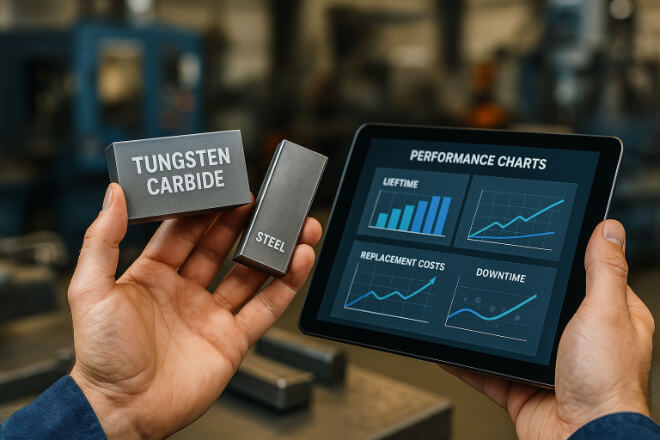
Le choix du bon matériau dépend de :
Type d'usure – abrasive, adhésive, par impact ou corrosive
Température de fonctionnement – les processus à haute température peuvent nécessiter du carbure
Taille des pièces – l’acier est plus économique pour les grandes pièces
Exigences en matière de durée de vie – le carbure signifie souvent moins de remplacements
Budget – planification des coûts à court terme et à long terme
Pour de nombreuses industries, la meilleure approche est une combinaison : utiliser de l’acier comme support structurel et du carbure de tungstène comme surfaces d’usure.
Conseils d'entretien pour maximiser les performances
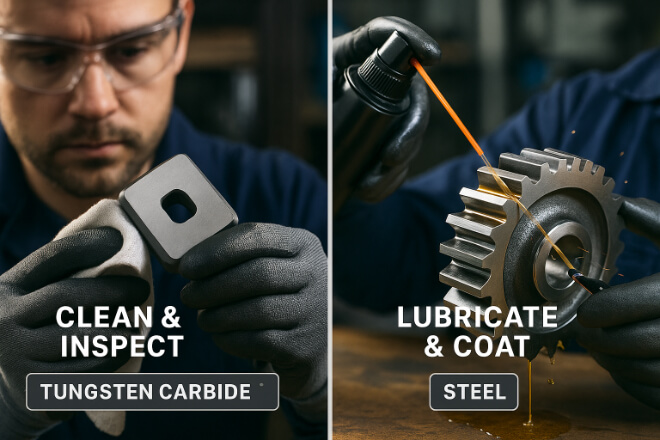
1). Pour le carbure de tungstène :
Évitez les impacts soudains
Utiliser un montage approprié pour éviter les fissures de contrainte
Nettoyer régulièrement pour éviter la corrosion due aux produits chimiques
2). Pour l'acier :
Appliquer des revêtements protecteurs pour la résistance à la corrosion
Maintenir la lubrification pour réduire l'usure
Vérifiez régulièrement l'absence de fissures ou de déformations
Conclusion
Dans le débat entre carbure de tungstène et acier, il n'y a pas de vainqueur unique. Le carbure de tungstène domine en termes de résistance à l'usure et d'applications à haute température, tandis que l'acier offre des avantages en termes de robustesse et de coût pour les applications structurelles et à forte résistance aux chocs.
Les décideurs doivent prendre en compte le coût total de possession, les besoins de performance et les conditions d'exploitation. Dans de nombreux cas, l'association de ces deux matériaux dans un même système offre le meilleur des deux mondes : durabilité et robustesse.
Si vous souhaitez en savoir plus sur une entreprise, n'hésitez pas à Contactez-nous.
